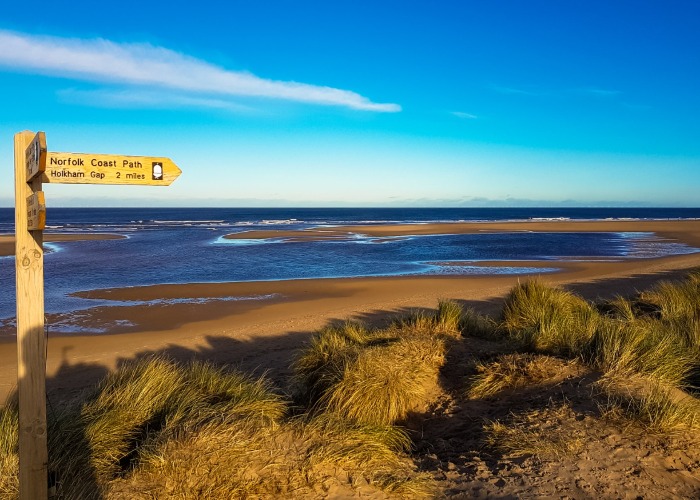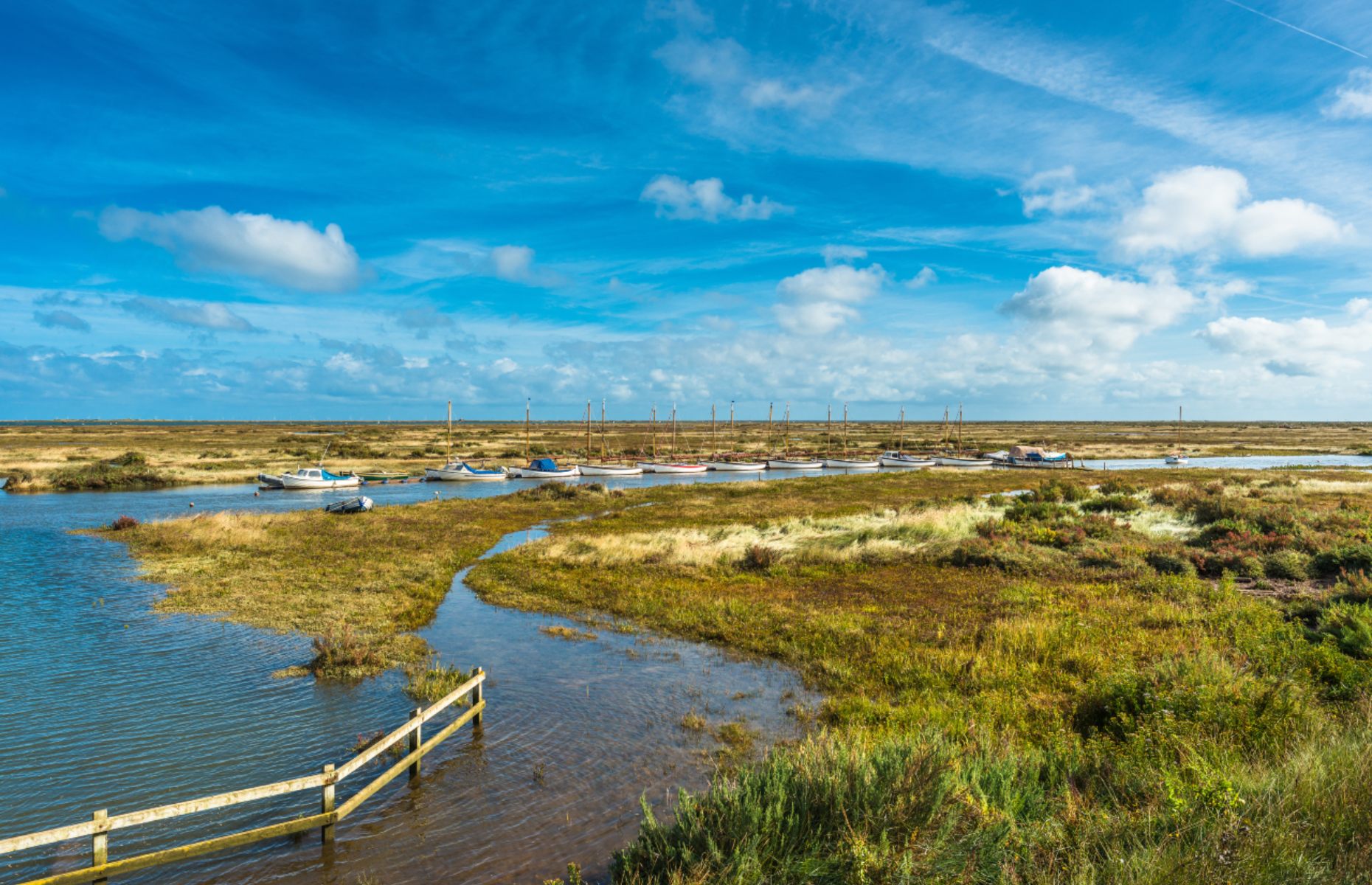
Norfolk’s award-winning beaches and quaint fishing villages have been luring Brits for centuries. Whether you’re after buzzy harbours brimming with activity, or want the area’s empty salt marshes and wild beaches all to yourself, we know the perfect place on the Norfolk Coast for you.
One day in ‘Nelson’s County’ can take you to desolate sand dunes, along peaceful creeks and past crumbling cliffs, with thriving villages and proud Victorian seaside towns to restore you along the way. With so much to see, it can be hard to know where to begin on the Norfolk coast. This guide gives you epic coastal paths, ancient finds, the county’s best beaches and unique shopping spots.
READ MORE: 7 reasons to visit the North Norfolk coast
1. For connecting with nature: Blakeney
Blakeney is a heady mix of narrow streets filled with traditional flint cottages, arty independent stores and miles of breathtaking scenery with sea views to boot. But for many visitors to this upmarket village, it’s the local wildlife which attracts them. Hike the Norfolk Coastal Path, which fringes the grazing marshes of Blakeney Freshes – home to the ground-nesting birds, lapwing and avocet.
Alternatively, get afloat with one of the regular seal trips to Blakeney Point. In summer, the four-mile-long (6.4km) shingle spit is home to one of the UK’s last remaining tern colonies and in winter, people flock there to see England’s largest grey seal colony. Make a night of it at The Blakeney Hotel, the AA recently awarded it four coveted Red Stars, or have a gastro-stay at nearby Morston Hall.

2. For a bird’s-eye-view: Happisburgh
The benefit of residing between two busy beach resorts is you can hide peacefully beneath the tourist radar, keeping your golden shores crowd-free. Happisburgh village is midway between busy Cromer and hectic Great Yarmouth. Clinging to infamously crumbly cliffs, it boasts miles of clifftop paths and a wild, sandy beach.
A popular spot for bracing winter walks, where storms often reveal fascinating archaeological finds – including 800,000-year-old fossilised footprints, the oldest found outside of the African continent. In summer, climb to the top of its iconic candy cane lighthouse and Norman church tower – on clear days you can see 30 churches and the Norwich Cathedral’s spire.
3. For windswept walk: Holkham Estate
A popular film location for Hollywood directors, the 25,000-acre Holkham Estate boasts an 18th-century Palladian mansion and what is probably Norfolk’s most famous beach. Backed by peaceful pine woods and the Holkham National Nature Reserve, the beach is as popular with families, horse riders and kiters as it is with A-listers. But don’t let that put you off, at low tide there's ample space on the golden sands, so it never feels crowded. It even has the royal seal of approval – if you visit in summer, you may be lucky enough to glimpse the Queen’s Household Cavalry galloping past.
4. For world-class birdwatching: Cley and Salthouse Marshes
Cley and Salthouse’s tangled muddy creeks are alive with the chitter chatter of rare birds. The salt marshes and reedbeds host six bird-watching hides, offering spectacular views across the creeks and scrapes. With an award-winning visitor centre and a delicious café, it has something for all the family. Foodies must visit (the smokehouse in Cley) the Cley Smokehouse and for lunch, head to The Dun Cow at Salthouse or Wiveton Hall Farm Café (open seasonally) – both have uninterrupted views across the marshes.
READ MORE: UK's most stunning natural wonders
5. For maritime tradition: Sheringham
Life revolves around the sea for inhabitants of this traditional Victorian seaside town, from the anglers that camp beneath its cliffs and the surfers, divers and fishermen that frequent its waters to the Shantymen that fill the town’s pubs with songs of the sea. The Blue Flag beach may be the obvious draw, but there’s plenty to do on dry land.
Sheringham Park's thousand-acre estate, famous for its rhododendrons, is worth a visit whatever the weather. Winter reveals the first butterflies of the year while the dawn chorus reaches a climax in spring. Foxgloves add a pop of colour in summer and autumn means one thing: fungi hunting. Sheringham is also home to the Poppy Line heritage steam train, which chuffs its way inland to the upscale Georgian town of Holt.
READ MORE: UK's most beautiful train stations
6. For a taste of the Broads without leaving the coast: Horsey
On windy summer days, locals can be found bunking down and basking in the sun in the dunes around Horsey. However, it’s winter that this beach really comes to life, literally. From late October locals flock to the dunes at Horsey Gap to watch the seals and their new-born pups.
Horsey is also one of the few places on the coast which offers visitors access to the Norfolk Broads. Just inland from Horsey Gap is Horsey Mere, with a photogenic windpump, wildlife boat trips and a reedbed walk alongside the mere itself – a great place to catch epic sunsets.
7. For a family day at the beach: Wells-next- the-Sea
This must be one of Norfolk’s best family beaches. Backed by pine woods and lined by pretty beach huts, this picture-perfect beach is a scenic mile from the town centre, which is full of independent shops, cafés and restaurants. Finish off at the quayside, enjoying great fish and chips, with boats bobbing in the background.
8. For independent shopping: Burnham Market
Just a mile inland, the upscale boutiques and second-homers of Burnham Market have earned the 17th-century village the nickname ‘Chelsea-on-Sea’. Joking aside, this attractive coastal village is ideal for a morning of mooching, with artisan delis, antiques shops, galleries and eateries galore. Need to walk off that lunch? Head to neighbouring Burnham Overy Staithe and then trek to empty sand dunes or kick back at nearby Brancaster Harbour and watch yachtie life unfold.
READ MORE: The best UK attractions to visit in 2022
9. For a taste of yesteryear: Cromer
Famous for its 500-foot-long (152m) long pier and delicious Cromer crabs, this quintessentially British Victorian seaside resort has been pulling in the crowd since the mid-1800s. Victorian buildings, beach huts and fishing boats fringe it's much-photographed shingle beach.
For a birds-eye-view take a walk along its dramatic cliffs before hitting the beach and rewarding yourself with the local seafood which fill its cafés and restaurants. Once you have tracked down the Banksy artwork (on the East Promenade), head to the pier to catch one of the UK’s last remaining ‘end-of-the-pier’ shows.